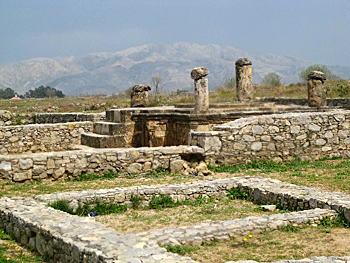 The Saka kings of Taxila had been influenced by the Irano-Parthian culture and ideals. They introduced into the India administration system the Saka Satraps after the Achaemenian model. Some of these satraps have been inferred from the inscriptions and coins but the locality of their rule cannot be determined.
The Saka kings of Taxila had been influenced by the Irano-Parthian culture and ideals. They introduced into the India administration system the Saka Satraps after the Achaemenian model. Some of these satraps have been inferred from the inscriptions and coins but the locality of their rule cannot be determined.
The centers where Satrap government under the Saka kings of Taxila appears to have been are the following:
(i) The north-western portion of the empire was possibly under the rule of the Satrap of Kapisa which included the present Kafiristan and the valleys of Ghorband.
(ii) After Azes I capturing the Puskalavati region, a Satrap was probably appointed to rule the region lying to the west of the river Indus.
(iii) The region of Swat valley was under the rule of the house of Vijayamitra since the time of Menander according to the Shinkot inscription.
(iv) Shahadaur inscription mentions a rajan Namijada or Daroijada who was also evidently a Satrap though the exact province which he ruled is unknown.
To the east of the river Indus there happens to be three satraps-Abhisaraprastha, Cukhsa in Taxila and Mathura. The Satraps of Abhisaraprastha and Cukhsa were subordinate rulers under the Taxila kings. Originally the Mathura Satraps were possibly the subordinate rulers but they became independent and adopted the title of mahaksatrapa.
(i) Cukhsa: It is generally believed that the modern Kutch, a broad alluvial plain in the north of the Attock District along the Indus River, preserves the name of Cukhsa. The satrap of Cuksha according to Marshall thinks that comprised of Peshwar valley on its west and most of the Hazara, Attock and Mianwali districts on the east.
(ii) Abhisaraprastha: According to the legend of a copper seal ling found in Punjab mention is made of Sivasena which is a Satrap in the town of Abhisaraprastha.
(iii) Some scholars think that the satrap of Mathura was vital and it was formed to keep a guard against the advancement of the Satavahanas who had occupied Malwa.
Later on it is found that Rajula became the mahaksat-rapa of Mathura. His coins are duplicates of the coins of Strato I and Strato II. It shows that he began his rule in the Eastern Punjab and later on became the mahaksatrapa of the Mathura region.
Rudra Simha, the last of the Satraps was killed. The fall of Saka Satrap is alluded to by Bana in his Harsha Charita "Chandragupta in the disguise of a female killed the Saka king possessed of lust for another`s wife at the very city of the enemy".



















